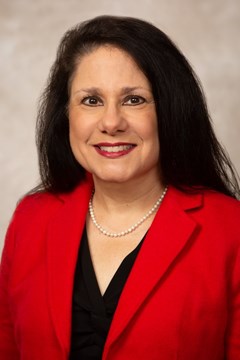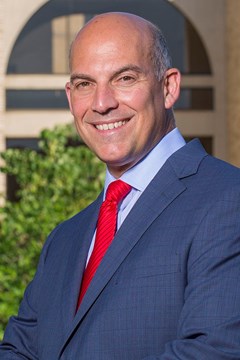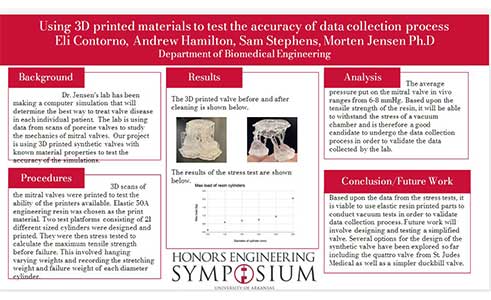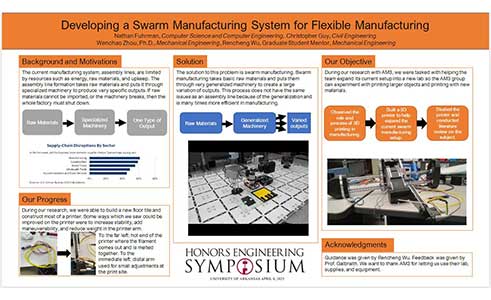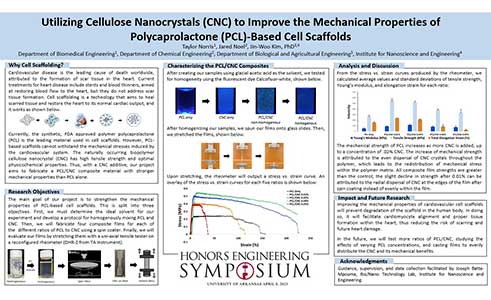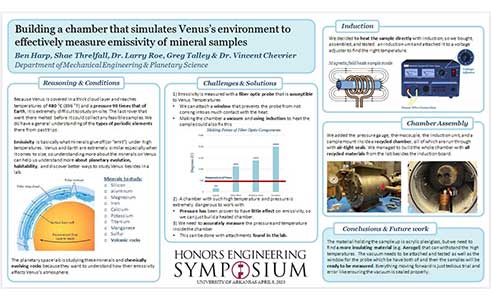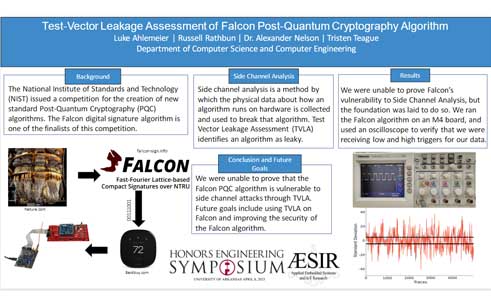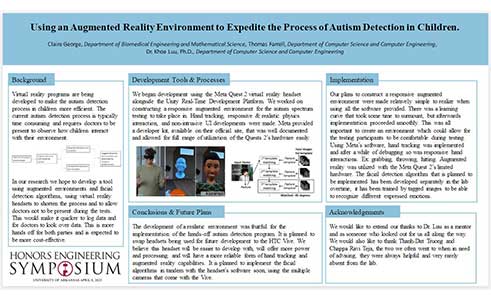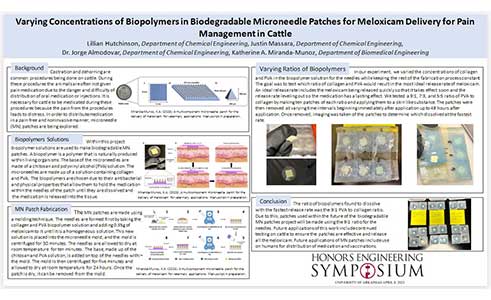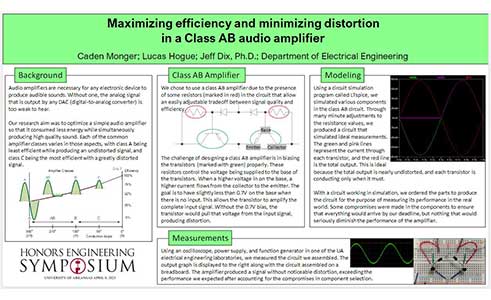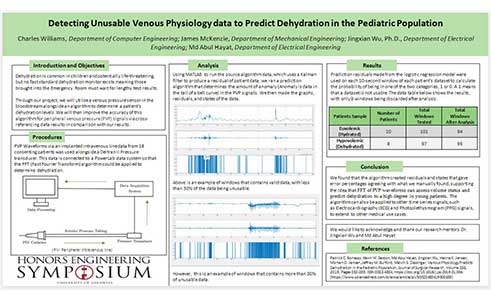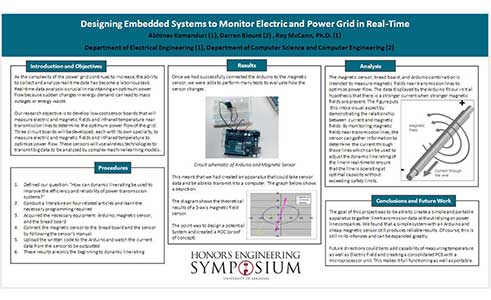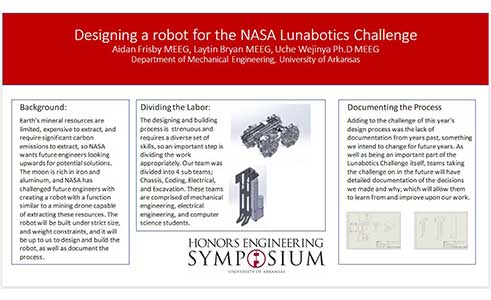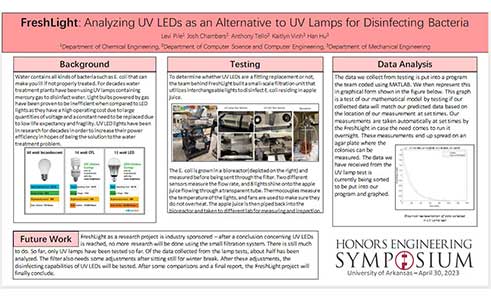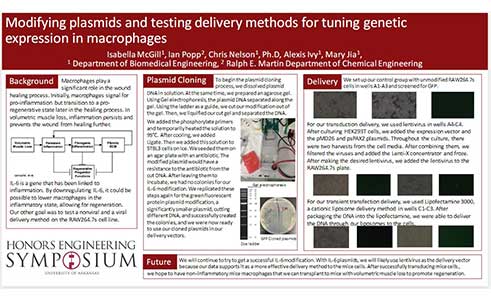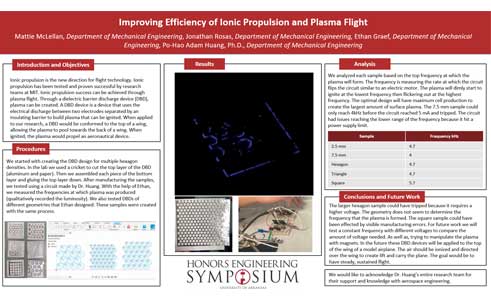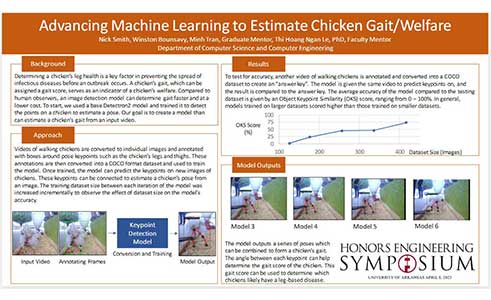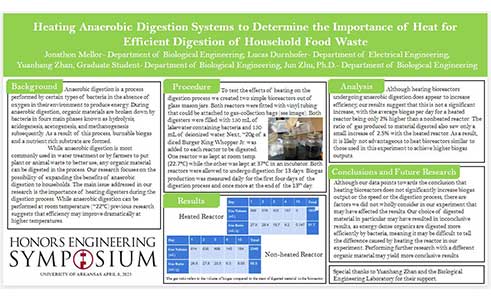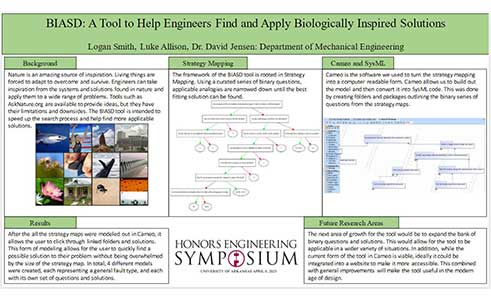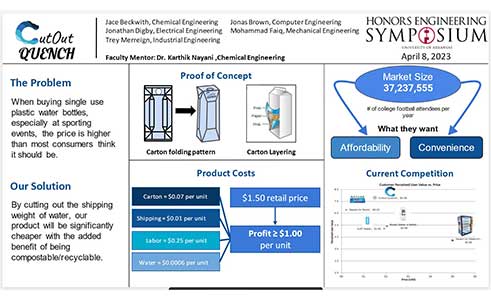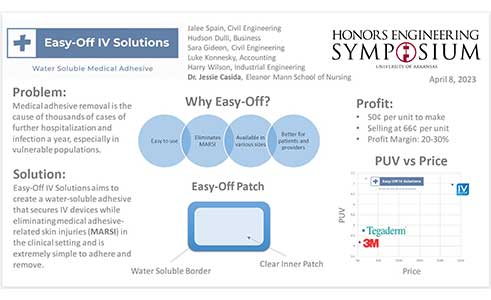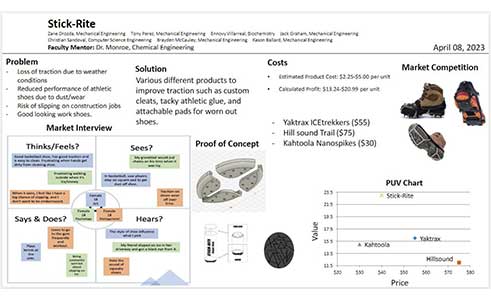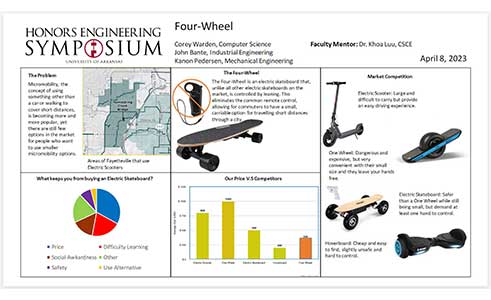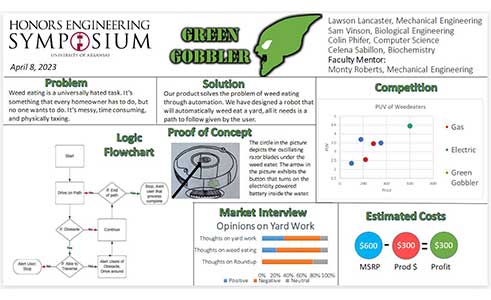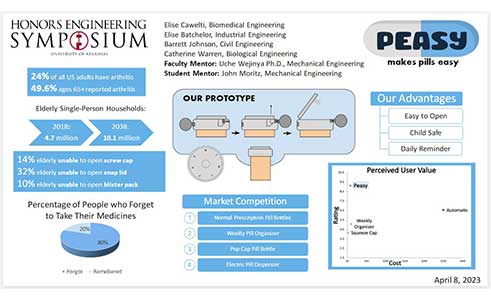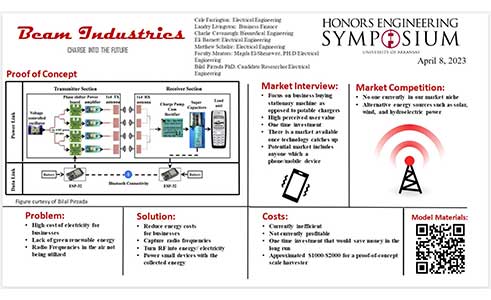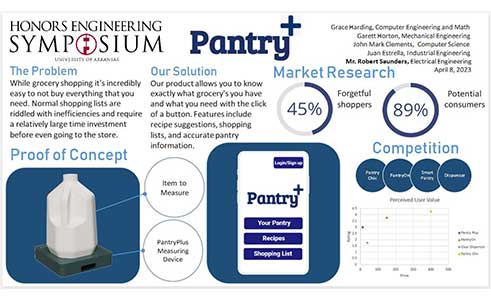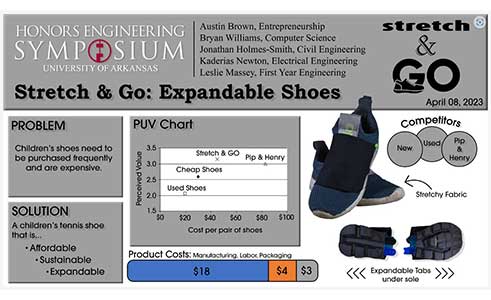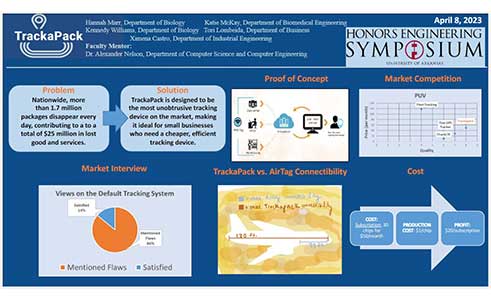
A MESSAGE FROM THE FIRST-YEAR ENGINEERING PROGRAM DIRECTOR
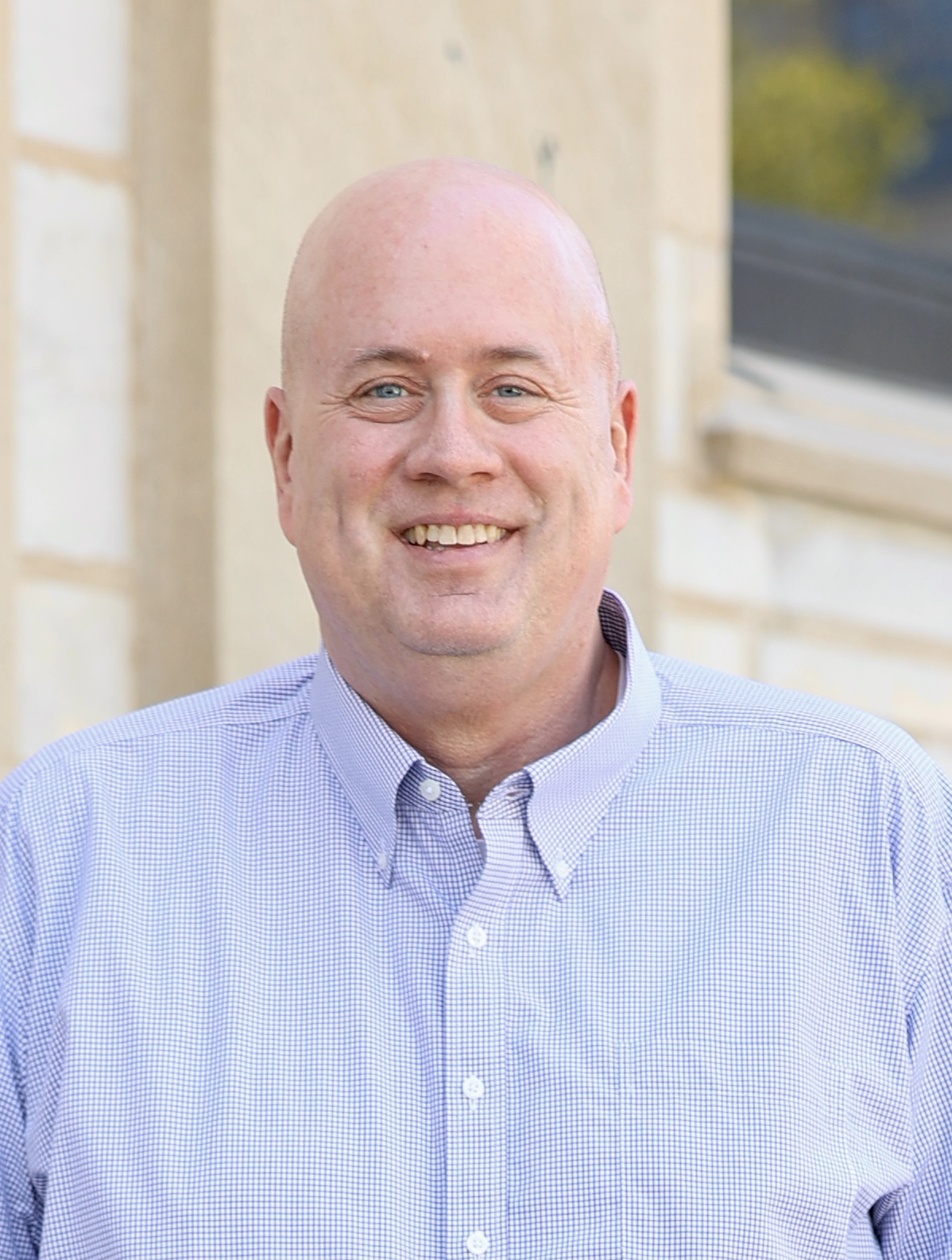
On behalf of the faculty and staff of the College of Engineering at the University of Arkansas, it is my pleasure to welcome you to the 15th Annual Honors Engineering Symposium. The purpose of the symposium is to showcase the research and innovation efforts of 76 first-year engineering students, five first-year business students, and four first-year arts and sciences students who are enrolled in the Honors College or Honors College Path program.
Forty students participated in a research colloquium during the fall semester in which they learned about various aspects of academic research in an engineering program. Throughout the year, the students have worked individually or in teams on projects mentored by College of Engineering faculty. The 19 research projects cover several areas of tremendous recent attention in the engineering professions.
Fifty-eight students participated in an innovation colloquium during the fall semester in which they learned about various aspects of innovation and entrepreneurship. Throughout the year, the students have worked in teams on projects mentored by University of Arkansas Faculty to help them with innovative design projects. The student teams also had to consider product market and business development plans.
The symposium will run concurrent presentation and poster sessions throughout the day. We invite attendees to attend the poster sessions and visit one-on-one with students about their projects. Attendees may also attend presentation sessions during which they can learn details of the projects. Everyone is welcome at the awards ceremonies.
I appreciate your support and again welcome you to our 15th Annual Honors Engineering Symposium.
Sincerely,
C. Richard Cassady, Ph.D.
Director of the First-Year Engineering Program
Dean Kim Needy, College of Engineering
Hello and welcome to the 15th Annual Honors Engineering Symposium. Today, we honor our students who are shaping the world of tomorrow! Participating in this symposium is a significant achievement, and you should be proud. Well done! You have gone above and beyond what is required of first-year students by choosing to participate in this research or innovation experience and for that we celebrate. Please enjoy the presentations and posters of those who will change research, product marketing and business development of the community, state, nation and the world.
Dean Kim LaScola Needy
Dean Matt Waller, Sam M. Walton College of Business
RESEARCH TEAMS
Using 3D Printed Synthetic Materials to Test Accuracy of Data Collection Process
Students
Andrew Hamilton | Biomedical Engineering
Eli Contorno | Biomedical Engineering
Faculty Mentor
Morten Jensen, Ph.D. | Biomedical Engineering
Sam Stephens, Graduate Student Mentor | Biomedical Engineering
Project Description
There are dozens of treatment options for the variety of mitral valve diseases that exist. Developing a computer simulation of the mitral valve would allow clinicians to tailor treatments to patient specific data. The methods for collecting data necessary to build an accurate simulation requires tedious suturing of porcine heart valve tissue into test chambers. 3D resin printed materials can be used to test this data collection process to ensure collected data is accurate.
Developing a Swarm Manufacturing System for Flexible Manufacturing
Student
Nathan Fuhrman | Computer Science
Christopher Guy | Civil Engineering
Faculty Mentor
Wenchao Zhou, Ph.D. | Mechanical Engineering
Renchang Wu, Graduate Student Mentor | Mechanical Engineering
Project Description
Swarm Manufacturing is a promising new technology that provides efficient general purpose manufacturing. Our focus is to help develop a swarm manufacturing platform in a lab setting. The university has already made great strides in this goal and have moved to expanding the current setup. We have worked on a couple parts of this expansion including assembling floor tiles and a SCARA 3D printer.
Utilizing Cellulose Nanocrystals (CNC) to Improve the Mechanical Properties of Polycaprolactone (PCL)-Based Cell Scaffolds
Student
Jared Noel | Chemical Engineering
Taylor Norris | Biomedical Engineering
Faculty Mentor
Dr. Jin-Woo Kim | Biological and Agricultural Engineering and Bio/Nanotechnology Group
Joseph Batta-Mpouma, Graduate Student Mentor | Biological and Agricultural Engineering and Bio/Nanotechnology Group
Project Description
Cardiovascular disease is the leading cause of death worldwide, attributed to the formation of scar tissue in the heart. Cell scaffolding is a promising technology in tissue engineering to address scarring, however, polycaprolactone (PCL), a common material used in scaffolds, cannot withstand the mechanical stresses induced by the heart. This project aims to strengthen the PCL-based scaffold with a cellulose nanocrystal (CNC) additive by determining the strongest ratio of PCL to CNC.
How Garlic
Extracellular Vesicles
Affect Cancer
Cell Proliferation
Students
Ella Martini | Biomedical Engineering
Molly Walker | Biomedical Engineering
Faculty Mentor
Dr. Young Hye Song | Biomedical Engineering
Emory Gregory, Graduate Student Mentor | Biomedical Engineering
Isabel Powers, Undergraduate Student Mentor | Biomedical Engineering
Project Description
Previous literature has shown that extracellular vesicles extracted from foods can be applied in a cancer cell culture. Our project observes the effect of garlic extracellular vesicles (EV’s) on cancer growth. We have established an isolation protocol that has allowed us to run tests on pancreatic cancer and benign cell cultures that indicate cell death, cell viability, and antigen content.
Building a chamber that simulates Venus’s environment to effectively measure emissivity of mineral samples
Students
Ben Harp | Mechanical Engineering
Shae Threlfall | Mechanical Engineering
Faculty Mentor
Dr. Larry Roe | Mechanical Engineering
Vincent Chevrier, Graduate Student Mentor | Planetary Science
Project Description
Because Venus is notoriously hard to study aerially and on site, we must learn more about how different minerals would react on the planet to understand planetary evolution and potentially even habitability. Scientists can use IR spectroscopy to measure what these minerals emit under Venus’s high temperature and pressure conditions. To do this, we are built a vacuum chamber that can heat a sample to 480 degrees Celsius.
Test-Vector Leakage
Assessment of Falcon
Post-Quantum
Cryptography Algorithm
Students
Luke Ahlemeier | Biological Engineering
Russell Rathbun | Computer Science and Computer Engineering
Faculty Mentor
Dr. Alexander Nelson | Computer Science and Computer Engineering
Tristen Teague, Graduate Student Mentor | Computer Science and Computer Engineering
Project Description
The emergence of quantum computers leads to the necessity for new standardized cybersecurity algorithms, which may be vulnerable to a cryptography attack method known as side-channel analysis, wherein hardware power data is collected and exploited to break that algorithm. Digital signature algorithms are of particular importance as a current underpinning of Transport Layer Security (TLS) and a mechanism to support proof-of-ownership. We conducted a hypothesis-driven research project to identify whether a current standardization candidate (Falcon) is vulnerable to side channel attacks.
Using an Augmented
Reality Environment
to Expedite
the Process of
Autism Detection in Children
Students
Claire George | Biomedical Engineering and Mathematical Sciences
Thomas Farrell | Computer Science and Computer Engineering
Faculty Mentor
Dr. Khoa Luu | Computer Science and Computer Engineering
Thanh-Dat Truong, Ph.D. Student Mentor | Computer Science and Computer Engineering
Project Description
Autism detection in young children is a very lengthy process. Shortening this process would benefit the children, families, and health care professionals involved. Our goal is to expedite this process by creating an augmented reality world in which autism testing can be conducted in. This will hopefully create an environment where the children feel more comfortable, decrease the cost of autism testing, and allow doctors to see more patients.
Varying Concentrations of Biopolymers in Biodegradable Microneedle Patches for Meloxicam Delivery for Pain Management in Cattle
Students
Lillian Hutchinson | Chemical Engineering
Justin Massara | Chemical Engineering
Faculty Mentor
Dr. Jorge Almodovar | Chemical Engineering
Katherine A. Miranda-Munoz, Student MentorStudent Mentor | Biomedical Engineering
Project Description
Microneedle patches are a method of drug delivery that can be used to distribute pain medication to cattle in a minimally invasive and pain-free manner. Biodegradable microneedle patches dissolve when applied to the skin, releasing the medication into the tissue, so for the medication to be fully released the patch must dissolve fully. This project tests different concentrations of the biopolymers that make the needles to determine the most effective concentration for drug release.
Maximizing efficiency
and minimizing
distortion
in a class AB
audio amplifier
Students
Caden Monger | Electrical Engineering
Lucas Hogue | Electrical Engineering
Faculty Mentor
Dr. Jeff Dix | Electrical Engineering
Project Description
An audio amplifier is a technology that amplifies, or increases the magnitude of, a signal. A desirable audio amplifier requires good energy efficiency and minimal distortion. One basic type of amplifier is the class AB amplifier, which divides the load between two transistors to increase efficiency. Our task was to balance the tradeoff between efficiency and distortion in a class AB amplifier using simulation and a physical model.
Using Venous Physiology to Predict Dehydration in the Pediatric Population
Students
Charles Williams | Computer Science and Computer Engineering
James McKenzie | Mechanical Engineering
Faculty Mentor
Jingxian Wu | Electrical Engineering
Md Abul Hayat, Graduate Student Mentor | Electrical Engineering
Project Description
Dehydration is common in children, but no standard dehydration monitor exists meaning those brought into the ER must wait for lengthy test results. Through our project, we will utilize a venous pressure sensor connected to the bloodstream alongside an algorithm to determine dehydration levels. We will then improve the accuracy of this algorithm via cross-referencing data results.
Designing Embedded Systems to Monitor Electric and Power Grid
in Real-Time
Students
Abhinav Komanduri | Electrical Engineering
Darren Blount | Computer Science and Computer Engineering
Faculty Mentor
Roy McCann, Ph.D. | Electrical Engineering
Project Description
As the complexity of the power grid continues to increase, the ability to collect and analyze real-time data is crucial to keep up with rising energy demands. The objective is to use an Arduino and sensors to measure electric and magnetic fields and infrared temperatures near transmission lines to monitor power flow. In order to use machine learning analysis, we can transmit the collected data to a local database.
Designing a Robot
for the NASA
Lunabotics Challenge
Students
Aidan Frisby | Mechanical Engineering
Laytin Bryan | Mechanical Engineering
Faculty Mentor
Dr. Uche Wejinya | Mechanical Engineering
Project Description
The resources available on Earth are limited and difficult to extract, and NASA wants future engineers to look upward for potential solutions. The moon is rich in aluminum and iron, and we have been tasked with creating an autonomous robot that would be capable of extracting these materials, built under strict guidelines.
Creating an Autonomous Robot Through Machine Learning and Integrated Cameras
Students
Brady Morgan | Computer Science and Computer Engineering
Hayden Threlfall | Computer Science and Computer Engineering
Faculty Mentor
Thi Hoang Ngan Le| Computer Science and Computer Engineering
Kashu Yamazaki, Graduate Student Mentor | Computer Science and Computer Engineering
Project Description
Through a machine learning algorithm, we have worked to teach the Unitree Robotics Go1 robot how to run itself when given a task. As of right now, the machine learning algorithm works only within simulations and not in the real word, but the main focus has turned away from the simulations and into computer vision in order to solve the Go1’s lack of depth perception by implementing the Microsoft Azure Camera.
FreshLight: UV LEDs as an Alternative to UV Lamps
for Disinfecting Bacteria
Students
Josh Chambers | Computer Science and Computer Engineering
Levi Pile | Chemical Engineering
Faculty Mentor
Dr. Han Hu, Faculty Mentor | Mechanical Engineering
Kaitlyn Vinh, Graduate Student Mentor | Mechanical Engineering
Anthony Tello, Graduate Student Mentor | Mechanical Engineering
Project Description
UV lamps have commonly been used to disinfect bacteria in fluids at a small-scale. LEDs have proven to be cheaper and more efficient, but their disinfecting ability has not been determined yet. The goal of FreshLight is to see if UV LEDs are an appropriate replacement to outdated UV lamps using a small personalized filter.
Tuning gene expression in macrophages for the purpose
of muscle regeneration
Students
Isabella McGill | Biomedical Engineering
Ian Popp | Chemical Engineering
Faculty Mentor
Christopher Nelson, Ph.D. | Biomedical Engineering
Alexis Ivy, Graduate Student Mentor | Biomedical Engineering
Mary Jia, Undergraduate Student Mentor | Biomedical Engineering
Project Description
Macrophages are white blood cells that repair damaged tissue by influencing inflammation. We will target Macrophages by modifying gene expression, so we can treat Volumetric Muscle Loss. We will be regulating gene expression with CRISPR silencing. This allows us to modify the cell’s RNA for the wound treatment. IL-6 can be silenced or activated using epigenetic regulation to impact macrophages. The results of our modification can be viewed using quantitative PCR.
Improving Efficiency
of Ionic Propulsion
and Plasma Flight
Students
Mattie McLellan | Computer Science and Computer Engineering
Jonathan Rosas | Mechanical Science
Faculty Mentor
Dr. Poa Adam Huang | Mechanical Engineering
Ethan Graef, Undergraduate Student Mentor | Mechanical Engineering
Project Description
This project is the start in understanding ionic flight and moving towards electric propulsion for aircraft. We are creating more efficient dialectic barrier discharge (DBD). These are grid structures that act like a capacitor with one plate and one grid. We are working to find the most efficient grid structure to be applied to a prototype plane to create enough lift to sustain flight.
Advancing Machine Learning
to estimate
Chicken Gait/Welfare
Students
Nick Smith | Computer Science and Computer Engineering
Winston Bounsavy | Computer Science and Computer Engineering
Faculty Mentor
Thi Hoang Ngan Le, Ph.D. | Mechanical Engineering
Minh Tran, Graduate Student Mentor | Computer Science and Computer Engineering
Project Description
A chicken’s gait characterizes leg weakness and is a strong factor to estimate a chicken’s health. Our system takes a video of a chicken’s back as an input and automatically outputs the gait score using machine learning keypoint estimation technique. At each frame, keypoints are detected using Detectron 2 and the angle between two legs is computed. The chicken’s gait over an entire video is computed using keypoints across frames by a 1D-Convolutional-Neural-Networks.
Analyzing the Benefits of Simple Heating Systems for Anaerobic Digestion in Households
Students
Jonathon Mellor | Biological Engineering
Lucas Durnhofer | Electrical Engineering
Faculty Mentor
Dr. Jun Zhu | Biological Engineering
Yuanhang Zhan, Graduate Student Mentor | Biological Engineering
Project Description
Anaerobic Digestion is a process that farmers commonly utilize to transform poultry litter-- (a combination of chicken feathers, bedding, and droppings)-- into a much more usable fertilizer as well. The process also produces a biogas that can be collected and burned for heat or light. In our research we will explore the plausibility of using anaerobic digestions in households, focusing on the implementation of heating implements which can greatly boost the efficiency of the digestion process.
BIASD: A Tool to Help Engineers Find and Apply Biologically Inspired Solutions
Students
Luke Allison | Mechanical Engineering
Logan Smith |Mechanical Engineering
Faculty Mentor
David Jensen, Ph.D. | Mechanical Engineering
Project Description
The BIASD tool is a system based on strategy mapping meant to assist in the process of Biologically inspired design. Our role is to take Dr. Jensen’s already mapped binary question series and analogies and turn it into a computer readable program. We are using the CAMEO SYSML software to do so. Doing this will speed up and simplify the process of finding biologically inspired designs, making it a more viable option for engineers.
INNOVATION TEAMS
CutoutQuench
Students
Jace Beckwith | Chemical Engineering
Jonas Brown | Computer Engineering
Jonathan Digby |Electrical Engineering
Mohammad Faiq | Mechanical Engineering
Trey Merreighn | Industrial Engineering
Faculty Mentor
Karthik Nayani, Ph.D. | Chemical Engineering
Project Description
Expensive water in venues is a consistent problem that shouldn't be. Our project aims to eliminate expensive water in venues by shipping renewable cardboard cutouts to the venues, folding the cutouts on site in our vending machines, and filling the cutouts with filtered tap water. This bypasses the expense of shipping of water in the bottles, making bottle prices significantly cheaper.
Easy Off IV Solutions: Water Soluble Medical Adhesive
Students
Luke Konnesky | Accounting
Harry Wilson | Industrial Engineering
Hudson Dulli | Economics
Jalee Spain | Civil Engineering
Sara Gideon | Civil Engineering
Faculty Mentor
Jessie Casida, Ph.D. | Eleanor Mann School of Nursing
Project Description
Medical adhesive removal is the cause of thousands of cases of further hospitalization and infection a year, especially in vulnerable populations. Easy-Off IV Solutions aims to create a water soluble adhesive that secures IV devices while eliminating medical adhesive-related injuries in the clinical setting, and is extremely simple to adhere and remove.
Stick-Rite
Students
Kason Ballard | Industrial Engineering
Christian Sandoval | Computer Science and Computer Engineering
Anthony Perez | Mechanical Engineering
Ennvoy Villarreal | Chemistry & Biochemistry
Jack Graham | Mechanical Engineering
Brayden McCauley | Mechanical Engineering
Zane Drozda | Mechanical Engineering
Faculty Mentor
Jacob Monroe, Ph.D. | Chemical Engineering
Project Description
We face issues walking in harsh slippery conditions every day, but does that really mean we have to keep buying new shoes to replace brand new looking shoes with worn down grips? Stick-Rite is the answer to that issue. We have innovated a solution to help you from not slipping in all different settings while still being able to show off your favorite shoe style.
4-wheels
Students
Corey Warden | Engineering
John Bante | Engineering
Kannon Pederson | Engineering
Faculty Mentor
Khoa Luu, Ph.D. | Computer Science and Computer Engineering
Thanh-Dat Truong | Computer Science and Computer Engineering
Project Description
There are safety issues with the leading alternative modes of transportation. This project explores solutions using an electric longboard by getting rid of the remote to free up a hand.
Green Gobbler
Students
Lawson Lancaster | Mechanical Engineering
Samuel Vinson | Biological Engineering & Interdisciplinary Studies
Celena Sabillon | Biochemistry
Colin Phifer | Computer Engineering
Faculty Mentor
Monty Roberts, M.S. | Mechanical Engineering
Project Description
Are you tired from your back hurting after an afternoon of weedeating? This pitch deck provides another solution for getting rid of those pesky weeds. We take a creative spin on the existing robot vacuum and apply it to lawncare.
Peasy: makes taking pills
easy peasy
Students
Elise Cawelti | Biomedical Engineering
Elise Batchelor | Industrial Engineering
Barrett Johnson | Civil Engineering
Catherine Warren | Biological Engineering
Faculty Mentor
Uche Wejinya, Ph.D. | Mechanical Engineering
Project Description
We created a lid for pill bottles that allows people with Arthritis or tactile strength problems to access their pills easily. We tackle three key objectives with our mechanical design: simple to open, safe to children, and easy to remember.
Beam Industries’
RF Energy Harvester
Students
Matthew Schulze | Electrical Engineering
Charlie Cavanaugh | Biomedical Engineering
Cale Farrington | Electrical Engineering
Eli Barnett | Electrical Engineering
Landry Livingston | Business Finance
Faculty Mentor
Magda O. El Shenawee, Ph.D. | Electrical Engineering
Bilal Sanauddin Pirzada, M.S. | Electrical Engineering
Project Description
In this pitch deck, our group is sharing a bold new way to power electronic devices. By capturing radio waves from the air we can convert that energy into usable power for charging devices. This allows for companies to save on power and for people to charge their devices with energy that only would’ve been wasted.
Pantry Plus: Simplifying
the pantry process
Students
Grace Harding | Computer Science and Computer Engineering
Garrett Horton | Mechanical Engineering
Juan Estrella | Industrial Engineering
Johnmark Clements | Computer Science and Computer Engineering
Faculty Mentor
Robert Saunders, M.S. | Electrical Engineering
Project Description
Is it possible to make shopping easier? To know exactly what you need with just a glance? This “Smart Pantry” allows our customers to do just that. With specific measurements and real time updates on your inventory, knowing what you have and what you need in your pantry will be a breeze.
Stretch & Go: Expandable
Kids Shoes
Students
Austin Brown | Strategy, Entrepreneurship and Venture Innovation (SEVI)
Kaderias Newton | Electrical Engineering
Bryan Williams | Computer Science
Jon Holmes-Smith | Civil Engineering
Faculty Mentor
Leslie Massey, M.S. | Environmental Engineering
Project Description
Orthopedic experts recommend that children's shoes should be replaced three to four times a year. Because children’s feet grow so quickly, parents purchase shoes that are too large for them in order to cut costs. This can be uncomfortable for the children and can lead to poor foot development. Our innovative product will revolutionize the children’s shoe industry by being a shoe that expands up to three sizes, reducing consumer costs and minimizing environmental impact.
TrackaPack
Students
Ximena Castro | Computer Science
Tori Lombeida | Business
Hannah Marr | Biology
Katie McKay | Biomedical Engineering
Kennedy Williams| Biology
Faculty Mentor
Alexander Nelson, Ph.D. | Computer Science and Computer Engineering
Project Description
Do you wish you could more efficiently track your packages? This pitch deck strives to effectively track individual packages from an economical standpoint over long distances. We minimize inadequacies of default tracking systems and place tracking power into our subscribers’ hands.
